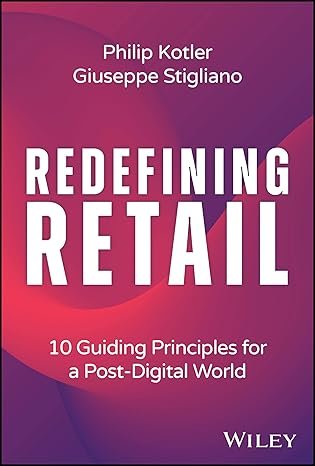
Summary of the Book’s Main Themes
“Redefining Retail” by Philip Kotler explores the rapid changes in the retail industry in response to technological advancements, shifts in consumer behavior, and the digital transformation of commerce.
Kotler discusses how traditional brick-and-mortar stores need to reinvent themselves to remain competitive in an increasingly digital world.
The book covers topics such as the integration of online and offline shopping experiences, the role of data in personalizing customer experiences, sustainability in retail, and the importance of fostering customer loyalty through meaningful engagement.
Kotler emphasizes the need for retailers to embrace new technologies like artificial intelligence, machine learning, and the Internet of Things (IoT) to create immersive and efficient shopping experiences.
He also highlights the changing nature of customer expectations, with a focus on convenience, personalization, and ethical business practices.
Writing Style and Structure
Kotler’s writing is clear, authoritative, and highly structured.
He uses a blend of case studies, theoretical insights, and practical advice, making the book both informative and engaging.
Despite the complex subject matter, Kotler breaks down intricate concepts into digestible sections.
The structure is well-organized, with each chapter focusing on a particular aspect of retail transformation, allowing readers to easily follow along without feeling overwhelmed.
While the content is rich with insights, the writing is geared more towards professionals and industry insiders, so it may come across as complex for casual readers.
However, the logical flow of ideas and frequent use of real-world examples keep the material accessible and engaging for those interested in the subject.
Strengths and Weaknesses
Strengths:
- Comprehensive Overview: The book offers a thorough exploration of the retail industry’s transformation, covering all the key technologies and trends shaping its future.
- Real-World Case Studies: Kotler uses numerous case studies from well-known brands, such as Amazon, Walmart, and Alibaba, to illustrate how retailers are successfully adapting to change. These examples provide valuable lessons for businesses of all sizes.
- Actionable Insights: The book not only explains the trends but also provides actionable steps for retailers to take advantage of new technologies and customer behaviors.
Weaknesses:
- Technical Jargon: At times, Kotler’s use of technical language can feel dense, particularly for readers unfamiliar with digital marketing, AI, or data analytics. This makes certain sections less accessible to a broader audience.
- Lack of Character Development: As this is a non-fiction, business-focused book, there is no character development in the traditional sense. However, Kotler could have made the narrative more engaging by including more personal stories from industry leaders or customer perspectives.
- Pacing: Some readers may find the pacing slow, especially in chapters that focus heavily on data analytics or deep dives into specific technologies. For those more interested in broad trends, these sections could feel overly detailed.
Effectiveness in Conveying Messages and Themes
Kotler is highly effective in conveying his core message: that retail is undergoing a seismic shift, and businesses must adapt or risk being left behind.
He explains the “why” and “how” of this transformation, balancing theory with practical application.
The book thoroughly explores the importance of customer experience, data utilization, and sustainability, making the case that businesses need to focus on these areas to thrive in the future.
One of the book’s strongest themes is its emphasis on customer-centricity—the idea that understanding and adapting to customer needs, values, and preferences is the key to success.
Kotler successfully drives home this point through various examples and strategic frameworks.
Comparison with Other Books in the Genre
Compared to other books on retail transformation, such as “Bionic Retail” by Gary Hawkins and “Retail’s Last Mile” by Chip Heath, “Redefining Retail” stands out for its academic rigor and breadth of coverage.
Kotler’s reputation as a marketing guru gives the book a sense of authority, and it is more comprehensive than many books that focus narrowly on specific technologies or trends.
While “Bionic Retail” dives deeper into the technological side of retail, Kotler provides a more holistic view, touching on digital transformation, consumer psychology, and sustainable business practices.
This makes “Redefining Retail” an excellent choice for readers looking for a well-rounded understanding of the industry’s future.
Overall Assessment
Redefining Retail is a must-read for retail professionals, business leaders, and anyone interested in the future of commerce.
Its depth of analysis and range of topics make it ideal for readers who are already familiar with the retail landscape but are looking to stay ahead of emerging trends.
For beginners, some sections may be challenging, but the practical advice and case studies make it worth the effort.
The book would especially appeal to retail strategists, marketers, and executives who are responsible for guiding their companies through digital transformation.
Casual readers or those outside the industry might find the material too specialized.
Final Recommendation
Is it worth reading? Absolutely, “Redefining Retail” is worth reading for those in the retail or business sectors.
Philip Kotler offers invaluable insights into how companies can adapt to and thrive in the rapidly evolving retail landscape.
The book is not only educational but also actionable, providing strategies that can be implemented across various business sizes and models.
However, for readers not directly involved in retail or digital transformation, the book’s technical depth may feel overwhelming.
Therefore, it is best suited to those with a vested interest in retail’s future.

